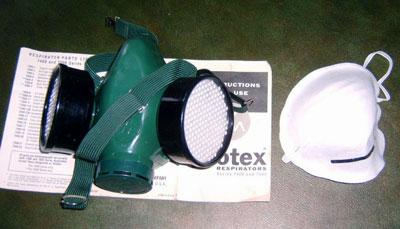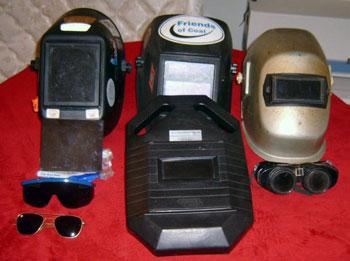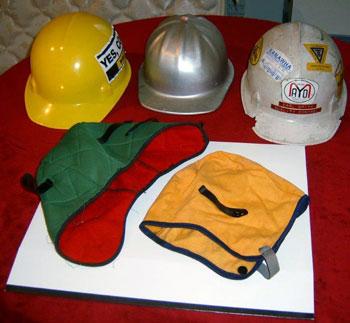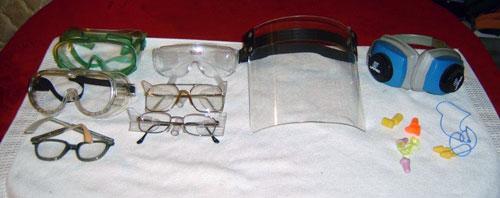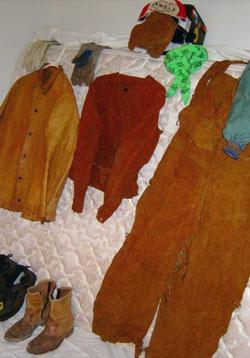AWS CWI, CWE, NDE Level III
- FMA
- The Fabricator
- FABTECH
- Canadian Metalworking
Categories
- Additive Manufacturing
- Aluminum Welding
- Arc Welding
- Assembly and Joining
- Automation and Robotics
- Bending and Forming
- Consumables
- Cutting and Weld Prep
- Electric Vehicles
- En Español
- Finishing
- Hydroforming
- Laser Cutting
- Laser Welding
- Machining
- Manufacturing Software
- Materials Handling
- Metals/Materials
- Oxyfuel Cutting
- Plasma Cutting
- Power Tools
- Punching and Other Holemaking
- Roll Forming
- Safety
- Sawing
- Shearing
- Shop Management
- Testing and Measuring
- Tube and Pipe Fabrication
- Tube and Pipe Production
- Waterjet Cutting
Industry Directory
Webcasts
Podcasts
FAB 40
Advertise
Subscribe
Account Login
Search
PPE in fabricating shops
Absolutely no excuse not to use it
- By Professor R. Carlisle "Carl" Smith
- January 2, 2014
- Article
- Safety
Personal protective equipment (PPE) is critical in a fabricating shop for several reasons, and it is difficult to understand why some people detest and refuse to use it.
The Occupational Safety and Health Administration (OSHA) has been instrumental in forcing companies to adhere to safety practices by setting and enforcing standards that must be followed to avoid costly fines.
Large companies have determined that having an OSHA-trained safety director is worth the cost. Community colleges now offer degrees in industrial safety that include OSHA certification. Metal fabrication shops have a strong need for safety programs that incorporate the proper use of PPE.
Welding processes and the material being welded create several hazardous conditions. One hazard that has drawn a lot of attention in recent years is chromium (VI). Chromium fumes and grinding dust present a danger that has caused many shops to avoid fabricating chromium-bearing materials, such as stainless steel.
A controversial subject, chromium (VI) concerns have led to several litigations. Workers have sued welding consumable manufacturers, and these providers in turn have sued the doctors who diagnosed their patients with lung or skin problems related to chromium (VI) exposure. Rules now are in place that require testing workers who have been involved in welding, cutting, machining, or just handling chromium-bearing materials. A simple 295 dust mask is recommended for protection from vapors and dust. Nitrile gloves usually are furnished to workers who only handle the materials.
There is nothing new about the need for protection when welding or grinding zinc and cadmium or any galvanized material. These materials are capable of producing phosgene gas that has caused serious ailments and even death. I had a friend who was brazing an old galvanized gutter on his house when he inhaled the phosgene gas and died immediately. The brazing rod that he was using also contained a small amount of zinc. He was not wearing any kind of breathing protection.
Although it is more cumbersome than a dust mask, the superior method of protection is a full respirator made specifically for harmful vapors and dust. A health-conscious welder actually wears one of these under his welding hood. Harmful vapors can be visible as they flow up and under the hood (Figure 1).
Welding Hoods
Eye protection also is of the utmost importance in a fab shop. I have witnessed more violations for this protection than any other. In most cases, it has been the use of incorrect protection for the job at hand.
Welders usually are aware of the damage arcs can cause. The ultraviolet rays immediately irritate the eyes, and the pain is such that no one wishes to endure it more than once. Bystanders who are unaware of the danger usually are caught without proper protection. Most shops have signage to warn against watching the arc, but some are so fascinated by it that they continue to watch the welder for long lengths of time. This, too, usually happens only once. It is impossible to forget the long nights of pain and discomfort.
Different types of welding hoods (helmets) are available for different types of welding. A relatively new one is called auto-darkening. When there is no arc, the welder has normal vision of the part to be welded. When the arc is struck, the lens automatically darkens to the shade the welder selected via a dial on the hood. This is especially advantageous to a fitter who is making short tack welds. It also is a godsend to the welder who is in a difficult position in relation to the weld area that is an unusual configuration, and there is no room to raise and lower the hood. These are priced a bit higher than a conventional hood, but most welders and fitters will tell you that they are worth every penny.
Some of the first hoods had very small lenses—2 in. by 4.25 in., the only size available for many years. They provided the welder with enough viewing area to make the weld, but nothing more. This hood also was available with a flip-front. The dark lens could be flipped up so the welder could see in normal lighted view.
The next size introduced was 3 in. by 5 in. It sold only for a short time until the 4.5-in. by 5.25-in. size came along and gave the welder a view above, below, ahead, and behind the puddle.
My personal favorite is the 4.5-in. by 5.25-in. model with the long dimension in the vertical position. This hood is really nice for the welder who wears bifocals. The original had the 5.25 dimension in the horizontal plane. The mirror lens of this hood is a great help when welding in a dark area because it reflects the very bright light from the arc onto the weldment. Also available is a hand-held inspector’s shield that is used strictly for observation (Figure 2).
Lenses
The lenses commonly available for welding hoods are shades 9, 10, 11, and 12. Younger welders usually prefer shades 11 and 12. Shades 9 and 10 work better as age causes the eyes to grow weaker.
For oxyacetylene welding and oxyfuel cutting, shade 5 lenses usually are preferred. These lenses are available in sunglass configurations as well as standard goggles. A common misconception is that the rays from oxyacetylene welding and oxyfuel cutting are not harmful. Research has shown that more permanent damage is done to the eye with these processes, because of the length of time the welder or cutter watches the flame and the metal being cut or welded. In any case, the arcs and sparks require special attention at all times!
Hard Hats
Some shops have difficulty requiring workers to wear hard hats. Employees have all kinds of excuses, such as headaches, neck strain, and hair loss, for not wearing them. Those who refuse to wear the cumbersome hats have never experienced some of the things I have witnessed and even experienced myself. Note the break in the hat on the right in Figure 3. I was hooking for an inexperienced crane operator when he swung the hook into my head. The hard hat flew off, but I only got a stiff neck from the accident. The hats are especially helpful in low-overhead working areas. A bump on a hard hat is much less painful than a bump on the skull.
The center hard hat in Figure 3 no longer is allowed in most operations. It is an aluminum hat that is lighter than the fiber models but is not suitable around electricity. One of our maintenance men wearing an aluminum hat bumped into a hot wire when climbing under a mining machine that we were rebuilding. He was knocked unconscious, but recovered in a few minutes. He gave me the hard hat to use for safety meeting demonstrations. It is a very good conductor, but the person wearing it is usually grounded and will receive a shock that could be fatal if high voltage is involved.
The yellow hat on the left is dielectric and is approved to ANSI Z89.1, Classes A, B, and C.
To make the hats more comfortable in inclement weather, skullcaps or helmet liners lined with flannel or wool are available. Some are brightly colored to make the worker more visible to a crane operator or forklift driver.
One way for a vendor to get exposure is to pass out stickers for hats and welding hoods. Toolboxes usually are decorated pretty well also.
Eye Protection
Several types of eye protection are available, and selection depends on the work to be done. Among these are regular prescription-type glasses with detachable side shields. Some goggles are made to wear over the prescription glasses. Some have a slight tint that is advantageous to a worker who is in a welding area but not close enough to need darker lenses. The goggles have a rubber band to hold them in place. Because this band can be very uncomfortable, larger safety glasses that can fit over prescription lenses were developed.
The prescription glasses come in many shapes and sizes. Large lenses are safer, but the stylish, small lenses are very popular. Personally, I would like to see a regulation on the lens size to make sure the whole eye socket is protected. Most side shields contain a cover for the corner of the eye that is vulnerable to overhead objects. A large gap at the edge of the glasses does not have proper side shields, and the eye is not protected from matter falling from above. At least one vendor offers glasses that have adjustable temples. A dime or a screwdriver allows a length adjustment, and the earpieces are made of an easily bendable material. The frames are heavy plastic; and they can be dropped several times for several feet without damage, unless they are scratched.
Polaroid lenses offer enhanced vision in dark areas. These are not safe (as a matter of fact, unacceptable) in welding areas, because they increase the brightness of the ultraviolet light.
It is difficult for the safety monitor to track whether a welder is wearing safety glasses under his hood. I have witnessed many cases of welding slag popping off and into a welder’s eyes when he raises his hood to examine the weld. This situation is a case in point for having eyewash stations at prescribed locations throughout the shop. An eyewash is even helpful to cool the eye when hot slag is involved. Easily visible signage should be posted near the stations.
A full-face shield with safety glasses (with side shields) should be worn for grinding (Figure 4). Sparks and grinding dust have no absolute pattern of travel; they can ricochet and go in any direction. A full-face shield protects the nose and mouth from breathing in particles that can’t be seen. In addition to the full-face shield and glasses with side shields, welders should at least wear a small dust mask to make sure the particles aren’t inhaled. When grinding stainless or zinc bearing material, welders should wear the vapor respirator shown in Figure 1.
Hearing Protection
Figure 4 also depicts several different types of hearing protectors. Small earplugs usually are sufficient for most shop noises. These are made in all shapes, sizes, and colors.
The sponge-like material allows the plugs to be inserted easily by squeezing them just before insertion. These plugs also protect the wearer from the shop dust and grinding particles. They should be cleaned after wearing or discarded if they are extremely dirty.
Larger earmuffs should be worn when the noise level reaches decibels in the 90s. This level is nearly always present during carbon arc cutting/gouging. Grinding sheet metal, especially on a thin-wall tank, produces unbearable noise and requires earmuffs.
Most companies provide hearing examinations annually, and the differences from year to year are recorded. Many workers’ compensation claims are filed by retirees claiming hearing loss. It is difficult for a company to prove that the worker did not wear proper hearing protection during his tenure.
Protective Clothing
Welders need to select clothing that eliminates or at least minimizes burns caused by ultraviolet rays, sparks, and slag that can pop off during slag-producing processes. Some shielded metal arc electrodes produce more sparks than others. The E6010 electrode has very little coating and thus produces quite the sparkler show. It is still the favorite for deep-penetration and downhill welding. Carbon arc cutting and gouging produces more sparks than any other process. The distance and force with which the sparks travel are greatly accelerated by the air required to remove the metal.
Welders should wear the full jacket shown on the left in Figure 5 when performing air carbon arc cutting or gouging. The leather flap shown at the top can be worn on the bottom of the hood toward the chest or the top of the hood to protect the back of the head and neck. This, along with the green skullcap that ties in the back, really helps.
Welders also should wear the high-top boots shown in Figure 5, and never tuck their pants legs in the boots. If a large chunk of gouged metal goes into the boot, it will cause 3rd degree burns before it can be removed. I have heard completely different languages spoken when this happens--words that seldom are heard at home and never in church.
The boots in the photo are well-worn. I prefer an inside zipper to a front zipper or lace-up boots. Slag can get trapped in either of the latter. It is rare for hot metal or slag to become caught in inside zippers.
Low-cut, steel-toe slippers are OK for gas tungsten arc or oxyfuel welding, but not for sparks or slag-producing welding. Supervisors and inspectors commonly wear this type of shoe. They are a little more comfortable than the high tops, but not nearly as effective in preventing burns.
The lambskin gloves shown at the very top left in Figure 5 are for gas tungsten arc and plasma welding. They also protect the hands when welders are using small tips with oxyfuel welding or brazing. Welders should never attempt to pick up a piece of hot metal with these gloves.
The large gloves adjacent to the jacket may be used for heavier welding jobs. The double-stitched, reinforced thumb area makes these gloves highly protective, even for air carbon arc cutting and gouging.
The short-bibbed, cape sleeves shown between the jacket and the complete bib probably are the most commonly used leather protection in the industry. They protect the most vulnerable areas of the body when the welder is standing, but not when he is welding overhead. The jacket is best for overhead welding.
The green slip-on sleeves are OK for light GTAW and GMAW. Not so great for SMAW.
The full bib, commonly called a bench welder, is for welding while seated. I once had a company called Hardweld. My fellow welders and I tipped drill bits for the water, oil, and gas industry. Part of the bit was submerged in water to protect the bearings, so we sat near the water barrel and deposited hard-surfacing material on the bit teeth. Insertable button bits did away with this method of rebuilding bits.
Special Precautions When Grinding
Welders should not wear loose clothing when operating a hand grinder. They need to tuck in their shirttail and keep the sleeves buttoned. Severe damage can occur if the grinding disk gets tangled in clothing. I witnessed a grinding accident that required nearly 100 stitches in the worker’s stomach.
A wire brush attached to a grinder can cause extensive injuries to the eyes or the skin. If the bristles become detached, they are capable of traveling several feet in any direction.
When Machining
Workers must always wear eye protection with side shields when machining to prevent shavings from entering the eye. Shavings sometimes move in a surprising direction.
Wearing loose clothing is not advised. Serious injuries and even death have been reported from clothing becoming wrapped up in a lathe operation. Most machining centers are preprogrammed and difficult to shut down from some positions.
The machinist should wear breathing protection when machining materials that produce hazardous fumes. Some operators become ill from inhaling the machine (cutting) oil that produces foul-smelling vapors.
Machinists also are susceptible to slipping and falling because of oil vapors falling on the floor. Oil-resistant shoes with rough soles to minimize the risk of falling should be worn.
The many types of PPE for specific uses are too numerous to describe. If industry can just convince workers of the importance of safety, we all will be safer. Training for equipment use is much improved and more available than ever before. There really is no excuse for failing to take advantage of the equipment and training.
About the Author

Professor R. Carlisle "Carl" Smith
Weld Inspection & Consulting
PO Box 841
St. Albans, WV 25177
304-549-5606
subscribe now

The Fabricator is North America's leading magazine for the metal forming and fabricating industry. The magazine delivers the news, technical articles, and case histories that enable fabricators to do their jobs more efficiently. The Fabricator has served the industry since 1970.
start your free subscription- Stay connected from anywhere

Easily access valuable industry resources now with full access to the digital edition of The Fabricator.

Easily access valuable industry resources now with full access to the digital edition of The Welder.

Easily access valuable industry resources now with full access to the digital edition of The Tube and Pipe Journal.
- Podcasting
- Podcast:
- The Fabricator Podcast
- Published:
- 04/16/2024
- Running Time:
- 63:29
In this episode of The Fabricator Podcast, Caleb Chamberlain, co-founder and CEO of OSH Cut, discusses his company’s...
- Industry Events
16th Annual Safety Conference
- April 30 - May 1, 2024
- Elgin,
Pipe and Tube Conference
- May 21 - 22, 2024
- Omaha, NE
World-Class Roll Forming Workshop
- June 5 - 6, 2024
- Louisville, KY
Advanced Laser Application Workshop
- June 25 - 27, 2024
- Novi, MI
























